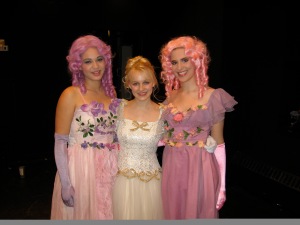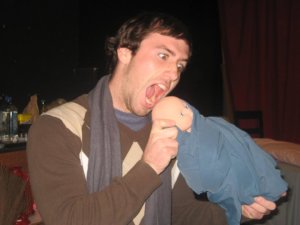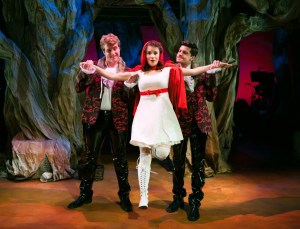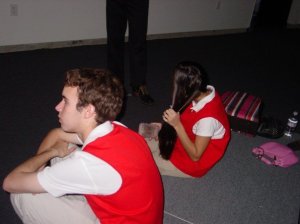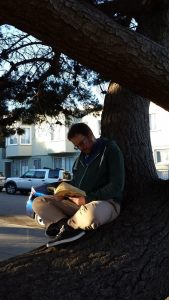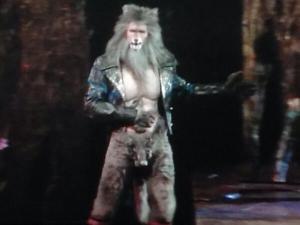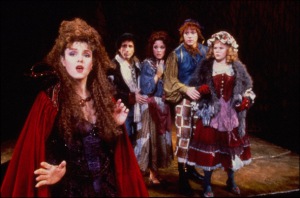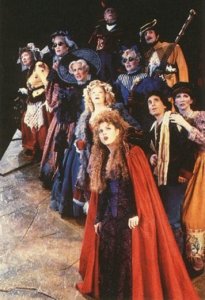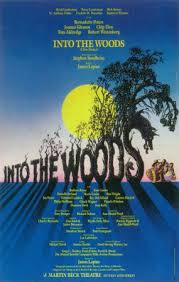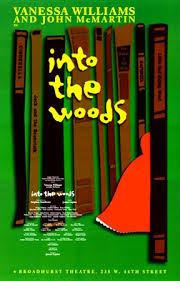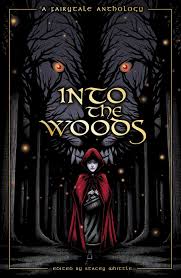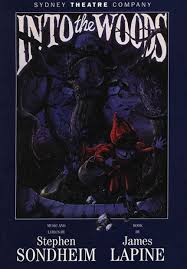Stuart Bousel wraps us up with a year-end wrap up.
Well, here we are again.
Another year has passed here in the Bay Area theater scene, and while many are saying 2016 was a cursed year, I personally found it to be a rather relentless year of change, challenge, growth, and ultimately: reward. Which doesn’t mean I’d do it all over again, but I have a hard time just writing it off either. For better or worse, and for the most part it’s been better though maybe not immediately apparent how so, a lot of stuff that kind of needed to happen, happened this year, and I’m grateful. I think I’m a smarter, stronger, more centered person, and a superior artist to who I was. Which isn’t the same thing as happy, but there’s a price for everything, right?
One of the many things that happened this year was that I branched out, or rather, I branched back out, expanding my participation in the form beyond the writer/director status I had more or less relegated myself to (and embraced) to also include acting, once again. The result was being cast in two shows, one of which, the Custom Made Theatre Company production of CHESS, became so time consuming I actually didn’t see a play by anyone else from August through November of this year. Even then I only just managed to catch Rapture Blister Burn at Custom Made, and if I wasn’t a staff member there it is debatable if I would have done so. I missed all but two nights of the SF Olympians Festival, and one of the two I managed to attend… was my own. That 2016 has been a largely successful year for me on the theater front is undeniably true, and no where is it more apparent than now, writing the Stueys, and finding I have a mere 26 shows to consider. That may seem like a lot, but usually it’s more like 40-50. The fact is, I was at the theater just as much if not more so than usual, but in 2016 the show I was most often at was one of my own.
Many things finished their course this year, including Theater Pub and DIVAfest, two organizations that were quite energy and time-consuming for me, and were indeed the equivalent of part-time jobs (though only one of them was I actually paid for). I’ve debated if the STUEYS should do likewise and end their reign of terror, but I rather enjoy publishing a personal Best Of list, if only to remind people, annually, that I do in fact like quite a lot out there. And because if there’s one thing I’ve come to understand about the Bay Area Theatre scene over the years, it’s far more diverse than most of the accepted press is willing or able to agknowledge, and so an additional voice is not only welcome, but necessary. Hence, here we are again, with all the usual caveats that no awards here mean anything beyond my personal admiration for the named artist, and that no rules apply to this process aside from my own personal whimsy when it comes to determining categories and recipients, and my own personal promise to not give myself or anything I creatively worked on an award because my vanity is a mere 7 out of 10.
So without further ado, the Stuart Excellence In Bay Area Theater Awards 2016, or the SEBATA, or The Stueys.
To all my friends and frenemies in the local rat race we call Art, let’s all do it again next year. But better. And maybe a little more paced out. Cause I am tired and I know I’m not the only one.
The Peter O’Toole Award For General Awesomeness: Jay Yamada
Do I really need to talk about how cool Jay Yamada is? I hope not. But then, if you haven’t worked with him, you might not know. The man is a saint, truly, and even better- he’s an artist, an excellent stage photographer who actually understands how to work with stage lighting and capture moments in shows you could never reproduce as posed shots. The Mohammed Ali of stage photogs, Jay is weaving around your actors at a final dress like a dancer, camera clicking away and sometimes inches from their faces, and yet amazingly unobtrusive. At the end of the night you know you’ll be walking away with at least 40 usable portfolio shots and press photos, and what’s more- your actors and designers will too, because Jay knows to get all that stuff and capture it in use, the way it should be captured. He often does this for dirt cheap or free if you’re a small company, and that’s just cool, providing the level of theater that needs it the most a touch of professionalism and gloss it might not otherwise get.
Best Thing I Saw But Didn’t Actually Like: The Lion (ACT)
I am a white guy who enjoys stories about white guys and acoustic guitar and I do not and will not apologize for it because some of that shit is gold. But man- you know a show is AGGRESSIVELY CAUCASIAN when even I am like, “Wow, this shit is white.” Still, Benjamin Scheuer does for white straight guys who make it through cancer what W;T did for white women who don’t, and if it’s a little Beaches in the mix to boot, all the better. His music is excellent, if utterly innocuous from the sampling in the show (I coined the term “innocurock” after seeing it), and he tells his story well, sincerely and without self-aggrandizement, owning where he comes from with everything from the Trunk Club wardrobe to the Lisa Loeb (™) brand bohemian apartment set, and it all works because the point is- even these guys die. Even these guys face a moment where they will be stripped of dignity and confronted with their insignificance and find out who they really are. When I say I didn’t actually like the show it’s because I found it low-stakes (I mean, we know it turns out okay, he’s sitting there performing it), a little saccharine (nobody in Ben’s life fails to find their place in his heart), and a little too polished (don’t tell us you were scared, Ben, show us, compromise that golden boy image you effortlessly project). But all that said, I found myself thinking, “I like this guy. He’s a good performer and a good spirit. I’m glad he’s okay. I hope he uses all this incredible talent and this second chance at life to make some really good art some day.” The Lion was, for me, all about potential- and realizing you have some. And that you shouldn’t waste it. Cause that clock is ticking, even if you’re a good looking heterosexual white kid whose life has been non-stop options (which, by the way, may actually make it easier to piss away your assets than someone whose daily existence is a reminder not to blow their shot), and I sincerely hope this was the prologue to something bigger in scope, and even better in execution.
The Best Thing I Saw Sans Qualifications: Colossal (SF Playhouse)
Against all odds, I loved this show. I say against all odds because I could care less about football. I don’t even hate it. I just don’t care. It’s like a thing that matters on another planet to people who in turn come from an even farther one from my daily reality and I just don’t get it. But man do I get falling stupidly in love with terrible people, hot gay sex, and the appeal of that which will probably destroy us, and playwright Andrew Hinderaker’s downright nasty, unapologetic, semen and sweat soaked script is one of the edgiest meditations on the mass appeal of self-destruction and its direct link to our urge to fuck one another that I’ve encountered in years. Beautifully directed by Jon Tracy, with some excellent performances (particularly the central character played by both Jason Stojanovski and Thomas Gorrebeeck, each bringing a distinct aspect to their interpretation of the role that highlights the disparity between who we are and who we perceive ourselves to be), the show managed to take some truly commendable risks and for the most part they all paid off in spades (the countdown clock behind the action at all times- brilliant! the relentless football drills- gorgeous!), somehow tricking me into accepting football not only as something people might genuinely want in their lives, but would like… make art about. And really good art at that.
Best Ambitious Failure: Cage (Performers Under Stress)
As usual, I feel like I first need to remind folks that I love very little as much as I love a Good Ambitious Failure. In fact, if pressed, I’d much rather watch a GAF than a Well Made Play any day of the week, because the former is much more likely to surprise me and one of the reasons I head to the theater is to be surprised. I feel like Performers Under Stress sort of specialize in the GAF, and Scott Baker’s continued forays into the realms unexplored and frequently ignored by the general theater community are worthy of a Stuey themselves, but this show in particular is a standout amongst their work that I have seen. Tar Gracesdóttir’s script is witty and interesting, though it borrows so heavily from the Joe Orton comedies that clearly influence it that it runs the risk of predictability and it devolves in to the sort of Facebook Status Update liberalism I’ve grown, as a liberal, to really detest. Still, Baker’s direction kept it moving, and Val Sinckler’s performance in the lead provided the perfect dose of skeptical every person required to make an otherwise alien group of characters at least contextually believable. It’s Valerie Fachman’s humane and sympathetic turn in a supporting role, however, that provided the evening with heart, and made me want to revisit the script again, and think about the production I’d just seen. Was it a perfect night? Far from it. But it got under my skin, and frankly that’s always the harder battle to win with an undeniably jaded audience member like myself.
Best Addition To The SF Theater Scene: Lily Janiak (SF Chronicle Critic)
Those of you wondering if this is me kissing ass in a very public way, rest assured, part of what I love about Lily as a critic is that she knows there are times I think she couldn’t be more spot on, and times I think she is full of pretentious nonsense, and my respect for her is in a large part due to my ability to express, publicly and privately, both of these perspectives at any given time, with the assurance that neither stance will influence her critique of my work, which has ranged from super flattering to just a shade less complimentary than that time the Guardian negatively compared my work to a Star Trek convention. Coming back onto the scene just a few months after she told me she was done with criticism, now bigger and bolder than ever, Lily has been shaking up the local theater scene in ways both admirable and terrifying, and I for one couldn’t be happier about it. Though she’s not my favorite local theater critic, she’s certainly one of my favorite local thinkers, and while some people will claim her importance as a wrench in the way we usually do things around here is the whole being female part, I would claim it’s got a lot more to do with being under 40 and not afraid to ask questions, particular of our very comfortable old guard who could use a little pointed poke in the grey matter now and then. If theater has a future in the Bay Area, it’s time we start getting some next generation (or really, this generation) perspectives and I can’t applaud the Chronicle more for going with someone exciting and fresh and smart and willing to put her mind out there. It’s not about kicking out the old, whose mentorship and legacy are invaluable, but we’re long past the point of making a place at the table for the new and this was an important step in the right direction. How excellent, as a director, to glance at the critic sector of the audience on opening night and see someone stuffing their bike helmet under the chair amidst that sea of venerable, adored, and largely white, gentlemanly heads. I might not always like what she’ll have to say, but then I can’t always predict what that’ll be either, and that, one artist to another, is delicious.
Best Synthesis of Tech and Action/Best Director: Cole Ferraiuolo/Maggie’s Riff (Faultline)
Look, I’ll be honest (cause that’s how I roll these days): I think Jack Kerouac sucks. I think he’s a shitty writer, and from what I’ve read he was a craptastic human being too, and yes I realize I’m basically telling you to revoke my San Francisco citizenship and my Reed College diploma. Jon Lipsky’s play didn’t do a thing to change my opinion, despite excellent performances from Paul Rodrigues, JD Scalzo, Nicole Odell, Rich Lesnik, and if anything it reinforced my assumption that having sex with Kerouac was probably like having sex with a bowling alley only less erudite, but what it did do was foster a new admiration for Cole Ferraiuolo’s abilities as a director, particularly in his ability to synthesize tech aspects of the show with the text aspects of the show to create an aesthetic whole that seemed almost seamless. In particular, the integration of shadow affects, by Alisa Javits, into the narrative highlighted the tension between truth and fiction, perception and reality, legacy and legend that provide the intellectual nut of the show. The piece felt like a fever dream, poetic and important, even if only to the dreamer, and the pacing, which is what kills so many shows for me, was pitch perfect from beginning to end.
Best Five Minutes: Justin Gillman and Cat Luedtke in Middletown (Custom Made Theatre Company)
Will Eno is a mixed bag for me. For everything I like and admire, from the language to the ideas, there’s a thing I’m twiddling my thumbs at, there’s a moment I’m wondering how something so bland can somehow inspire such passionate praise. Middletown epitomizes this for me, and is why if someone asked me “where to begin” with Eno, I would send them here, with the caveat of, “it’ll leave you unsatisfied- which I think is how it’s supposed to leave you- which means I think you’ll have successfully gotten it and him? I don’t know. It’s not really my thing. Even though it kind of is.” That said, my single favorite five minutes of theater this year was in the Brian Katz directed production at Custom Made Theatre Company, and it happened in the second act, when Cat Luedtke’s doctor encounters Justin Gillman’s lunatic and decides to help him out with some birthday drugs she “spills” from the supply of pain killers she apparently just wanders around with. If Brian excels at anything as a director, it’s a kind of stoic naturalism, and in a scene between two such archetypes, it’s his light hand that allows for two excellent actors to soak in the relationship and find the nuances that turn this five minute scene into a stand-alone one-act I’d award Best Short Play to if I could. No where else in the production was that theme of the extra-ordinary ordinariness of things better realized, and the moment was at once sad and funny and romantic and real, like a treasured scene of an early ‘aughts indie film I would have, at another point in my career, played on repeat to actors insisting “that’s how you do that.”
Best Actress In A Thankless Role: Melanie Marshall, Peer Gynt (ArtistsRepSF)
There are a lot of thankless roles out there, male and female, but women more often than not, through sheer numbers, end up in parts that, while not necessarily bad parts, are still just kind of thankless. For every regal queen role, or unrepentant murderess, or inspiring historical figure, or mold-breaking heroine who takes center stage or at least holds her own on the supporting side, there are like three times as many handmaidens, best-friends, random sexies, and blandly supportive mothers or love-interests. Solveig in Peer Gynt falls into the last category, though too his credit Ibsen attempts to give her some personality, he just also sort of forgets about her for 2/3rds of the play after she’s introduced, bringing her back at the end once his hero has learned an important lesson- one she embodies, thus rendering her not just a personified concept, but a kind of reward. That Solveig has a little more grit to her in the Artists’ Rep adaptation of Peer Gynt is no doubt partly due to Oren Steven’s revisioning and direction, but it’s hard to imagine anyone having brought to the role what actress Melanie Marshall was able to bring through a unique combination of earthiness and no bullshit deadpan. Often times Solveig feels beautiful and forgiving, but because she has to be (that’s how she was written to be). Melanie made it clear her Solveig was making it work as a choice- her choice- and that nobody, starting with Peer, should take it for granted. As a long time fan, for all its flaws, of the original work, it was impossible not to be charmed by this fresh take on the character, and even wish that a full spin-off revisioning, WICKED-style, was in the works somewhere, preferably with Melanie at the helm.
Best Surprise, The Big Hot Mess (DIVAfest)
To know Catherine Debon is to know a true San Francisco original, though Parisian in origin (but then, true SF Originals are almost always from somewhere else, right?). A femme fatale come to life, a dancer and performer, a writer and thinker, Catherine has been creating unusual and challenging performance work in the Bay Area for years, but with The Big Hot Mess, directed by Amanda Ortmayer and featuring Kevin Copps in a supporting role, she gave us something unique and unusual even for her. Part film noir, part performance art, this exploration of time and agency, and the relationship between the two, made use of duct tape and wall-clocks, movement and voiceover, one slinky black dress and one fedora to illustrate how our personal sense of control over our lives slips as we age and find ourselves progressively written out by the world around us. As the guy who had done some publicity work on this piece, I knew to expect something heady and stylish, but what I wasn’t expecting was to be utterly and thoroughly delighted by the end product, for it to be by turns elegantly self-aware and comically absurd, yet at its core a heroic journey, a depiction of one woman’s willingness and ability to stand up for what was right. A total inversion not only of the noir genre, but the medium of performance art in general, The Big Hot Mess was anything but, and the only time this year I found myself saying, “Yeah, I know I was paid to tell you to see this- but you really really should see it. It’s so good!”
Best Spirit: Terra Incognita: Through The Waves (DIVAfest/UpLift Physical Theatre)
I feel like it’s already a bit of a legend, how on opening night of this piece, created and performed by Juliana Frick, Hannah Gaff, and Nicholette Routhier, the soundtrack didn’t work and the show went on anyway, with all three women performing in absolute silence to an awestruck theater full of people wondering how you could pull off a movement piece without the music and soundscape it had been created to. As we sat rapt for thirty minutes, watching them tumble and lift and dance and roll with only the patter of their feet and the slap of their skin against the lone piece of scenery, a table, to accompany them, I remember thinking, “This is what it means to be an artist- and to be a small theater artist- this right here.” While a bigger company would have canceled the night, refunded the tickets, and maybe should have, that was not only not an option for these women, but ultimately an asset. When you’re in the business of making art that is raw and real, you know you can’t back down because the tech craps out. When your art gets better because you didn’t back down, that’s when you know you’re the part that’s raw and real.
Best Designer: Carlos Aceves, Scenery For The Awakening (The Breadbox)
The Breadbox’s production of The Awakening, adapted by Oren Stevens and directed by Ariel Craft, earned a tremendous amount of attention this past year, including a truckload of TBA Awards and critical praise, and all of it was, unquestionably, deserved. I could heap more praise myself, but decided that in the spirit of the Stueys, which try to highlight some stuff left off the other Best Of lists, I thought I would call attention to what was one of my favorite aspects: the simple and yet evocative set design that captured beautifully the turn of the century Gulf coast community in which the action was set. One of the more transformative sets I’ve seen in the EXIT Stage Left, Carlos Aceves’ combination of boardwalk and driftwood echoed with Louisiana elegance and bygone nostalgia, evoking not just the sea but the beach, specifically, and the cultures that grew up around The Shore. From the knots in the wood to the knots in the hammock, there was a graininess to it all that practically bled sepia-toned photographs, and sucked you into the world that had to be real before any of the conflicts happening inside of it could truly be understood in context. A precise blend of conceptual and literal, the set accented perfectly everything else the show so adeptly executed.
Image That Will Stay With Me The Most: Mikka Bonel/Amy Sass (A Whale’s Wake, The Flightdeck)
Amy Sass is an admirable theater artist for a number of reasons, but if I had to pick one, it’s this: girlfriend does not compromise her vision. Sometimes this is a wonderful thing, and sometimes it’s a questionable thing, but for what it’s worth, we don’t do art so the audience will be indifferent about it and Amy Sass seems to not only get that, but embody it. There was a lot about her play A Whale’s Wake that I admired, and some I sort of rolled my eyes at, but if I had to pick one moment from any show that I saw this year that best epitomizes this year it’s without doubt from Amy’s personal spin on the domestic drama, and that oldest of tropes in the domestic drama trope bag: the reluctant mother giving birth. In this case, because it’s Amy, she gives birth during a flood, as she’s swept out to sea, and said baby sort of ballet dances away on its umbilical cord, before said cord is severed by a Dude Who Fixes Everything trope. I know this sounds ridiculous, and it was, but somehow, thanks to Amy’s direction, and Mikka Bonel’s icy but graceful performance as the mother, it also worked, and seared itself into my imagination forever. What is life if not the wondrous and terrible moment of seeing your newborn hoisted out of you by forces beyond your control?
And so, there you go. Another year, another list. Hopefully you found it as amusing to read as it was for me to write.
Now, as I sit in the living room of my new apartment (I moved in October of this year, just one of many difficult changes that made me better), tying all this up, I suddenly find myself thinking that while in some ways I flew a little more under the community radar than usual this year (no TBA Award nominations, and I skipped the conference; lower attendance of shows than usual, and more stepping away from administrative roles than times past; and I went to virtually nobody’s parties), I still directed my favorite play, John Guare’s Six Degrees of Separation at Custom Made, had the honor of having my play Adventures in Tech directed by Allison Page at PianoFight, and ended the year directing the American premiere of Clive Barker’s gorgeous Paradise Street at the EXIT Theatre. A show of mine was done in Chicago, I mounted a collection of short plays about a pop star I idolize, Rob Ready slew another llamalogue I wrote, I had a reading in New York, I built a new works development program, I worked with awesome artists in a variety of ways, and I sang in front of paying customers for a month solid and nobody threw anything at me. Not every moment was perfect but in many ways, it was actually a bumper year as far as me doing what I wanted as an artist, though somewhat ironically, I also felt a little more on the outside of the community, for reasons I really can’t quite explain. At the back of my head, of course, I recognize it’s probably got something to do with having followed my own bliss a bit more whole-heartedly, un-appologetically, and occasionally at the sacrifice of passionate obligations and social politicking that at another point in my career would have called the shots more. I de-friended more of my fellow theater artists this year than ever before (albeit mostly due to the election), while at the same time expanding my collaborative circles exponentially, and though I suspect my approach to my own trajectory has always been complex if not outright paradoxical (can one be as diplomatic as I aspire to be, while also holding their integrity as close to the core as I also aspire to do?), I suppose what’s changed is that I’m no longer fighting that intrinsic tension, but rather embracing it. It’s about recognizing that everything is a mixed bag, including me, including everyone else, and sort of shrugging at the people who can’t accept that (or me) and letting them learn that without feeling the need to personally educate them- or apologize for not living up to their idea of what and who I’m supposed to be. Not everything is going to go according to plan, not everything battle is going to be won, not everything is going to be to your standards, but that’s okay. And also how it kind of has to be. Accept it, celebrate it, or let it go and celebrate that, but don’t let it stop you. If there’s one thing 2016 taught me, it’s that: don’t let it stop you. And don’t wait for people to catch up.
The right people always will.
Editor’s Note: In an effort to get this out before the end of the year, numerous grammatical and spelling mistakes have no doubt been made, and as such, will be edited in the future in an effort to uphold some kind of standard.
